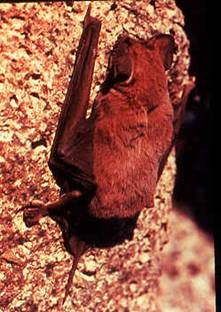
The Molossidae, or free-tailed bats, are a family of bats within the order Chiroptera. The Molossidae is the fourth-largest family of bats, containing about 110 species as of 2012. They are generally quite robust, and consist of many strong-flying forms with relatively long and narrow wings with wrinkled lips shared through their genus. Their strong flying forms allows them to fly 60 miles per hour using tail winds and at altitudes over 10,000 feet. This makes them unique among bats, as they are the only bat family that withstands the elevation. They are widespread, being found on every continent except Antarctica. They are typically found in caves, abandoned mines, or tunnels.

Micronomus norfolkensis is a species of molossid bat, a family of flying mammals. The bat is endemic to Australia, where it occurs from southeastern Queensland to eastern New South Wales. They are the sole species of genus Micronomus and referred to by variations on east-coast free-tailed bat.

Ozimops planiceps is a small bat in the family Molossidae, native to Australia and Indonesia.

The Natal free-tailed bat is a species of bat in the family Molossidae, the free-tailed bats. It is native to the islands of Mauritius and Réunion. It is known from fewer than five locations in its range, but it is common at a few sites. It roosts in caves, and it is considered to be an endangered species due to disturbance of its cave habitat.

Peters's wrinkle-lipped bat(Mormopterus jugularis), also called Peters's goblin bat, is a species of bat in the family Molossidae, the free-tailed bats. It is endemic to Madagascar, where it is widespread and in some areas abundant. It commonly roosts in human-made structures, sometimes in colonies with other free-tailed bat species. It forages in the open, often in agricultural areas. The bat is sexually dimorphic, with males larger than females.

Ansorge's free-tailed bat is a species of bat in the family Molossidae native to sub-Saharan Africa. It is named for W.J. Ansorge, who collected the first formally described specimen.
Grandidier's free-tailed bat is a species of bat in the family Molossidae. It is endemic to Madagascar. Its natural habitats are subtropical or tropical dry forests and dry savanna. It is threatened by habitat loss. It has at times been considered synonymous with the little free-tailed bat.
The lappet-eared free-tailed bat is a species of bat in the family Molossidae. It is found in Benin, Burkina Faso, Democratic Republic of the Congo, Ivory Coast, Ghana, Guinea, Kenya, Liberia, Mali, Niger, Nigeria, Sudan, Tanzania, Togo, and Uganda. Its natural habitats are dry savanna and moist savanna. It is threatened by habitat loss.

The little free-tailed bat is a species of the genus Chaerephon in the family Molossidae. It is widely distributed across Africa and islands around the continent.
The São Tomé free-tailed bat is a species of bat in the family Molossidae. It is endemic to São Tomé and Príncipe. Its natural habitats are dry savanna, moist savanna, and plantations. It is threatened by habitat loss. Only three individuals have ever been documented.

The Midas free-tailed bat is a species of bat scientifically classified in the order Chiroptera and the family Molossidae. It is distributed from western Africa to Saudi Arabia and further south. Its natural habitats are dry savanna, moist savanna, woodlands and hot deserts. The more southern are also known to live around large rivers or the swamps. It is threatened by habitat loss.

The Egyptian free-tailed bat, also known as Egyptian guano bat or Egyptian nyctinome, is a species of bat in the family Molossidae.

Chaerephon is a genus of Old World free-tailed bats in the family Molossidae. Molecular sequence data indicates that Chaerephon, Mops and Tadarida are not monophyletic taxa. The closest relatives of Chaerephon jobimena of Madagascar are Tadarida aegyptiaca of Africa and southwest Asia, and Tadarida brasiliensis of the Americas, which form a clade believed to be about 9.8 million years old. However, the grouping of Chaerephon minus C. jobimena plus Mops was found to be monophyletic.

Mops is a genus of bats in the family Molossidae. Molecular sequence data indicates that Mops and Chaerephon are not monophyletic taxa. However, the grouping of Chaerephon and Mops was found to be monophyletic when excluding C. jobimena.

Gallagher's free-tailed bat is a free-tailed bat endemic to the Democratic Republic of the Congo. Only one individual has ever been documented.

Chaerephon jobimena, commonly known as the black and red free-tailed bat, is a species of bat in the family Molossidae. It is endemic to western Madagascar. With a forearm length of 45 to 48 mm, C. jobimena is somewhat larger than other Malagasy bats assigned to Chaerephon, but similar in size to Tadarida aegyptiaca.

Harrison's large-eared giant mastiff bat is a species of bat found in Northeast Africa and the Arabian Peninsula. It was described as a new species in 2015. The IUCN evaluates it as a vulnerable species.
Chaerephon pusillus is a species of bat in the family Molossidae. It is found on islands of the coast of east Africa.















